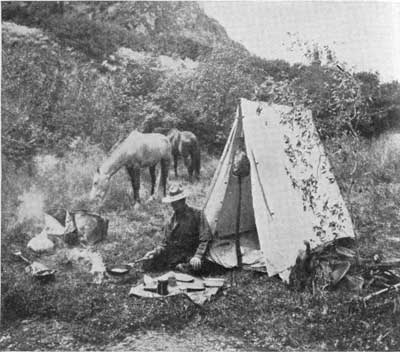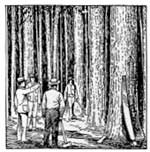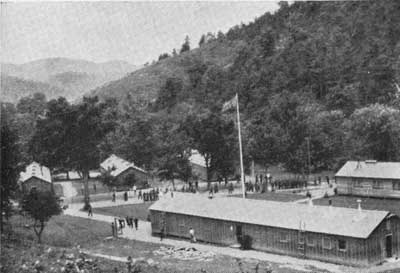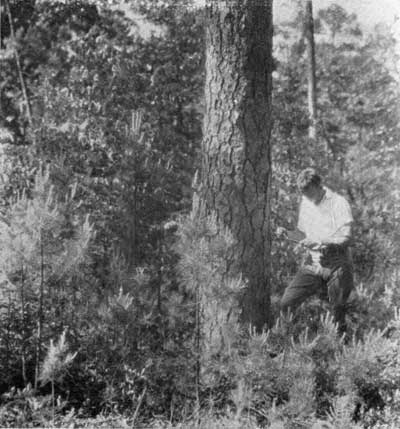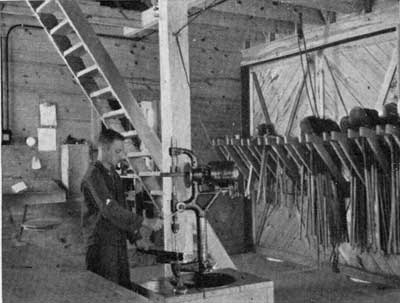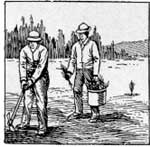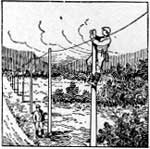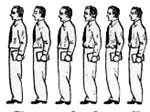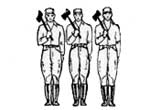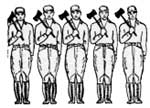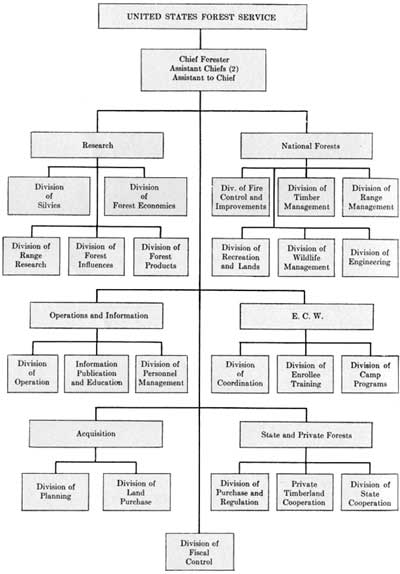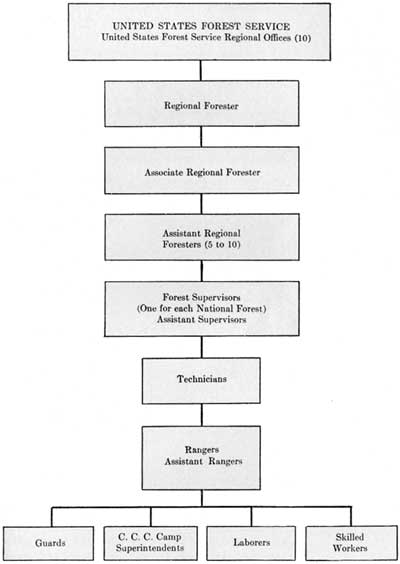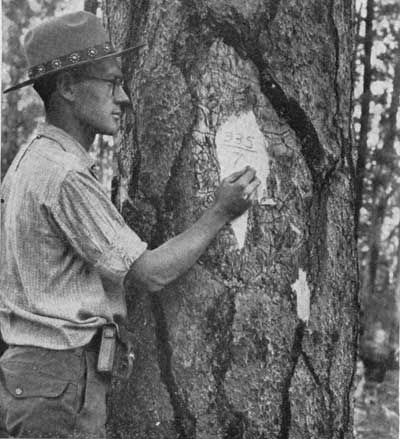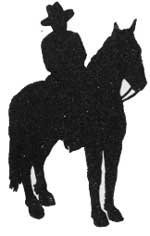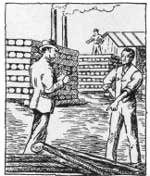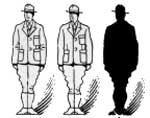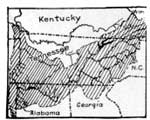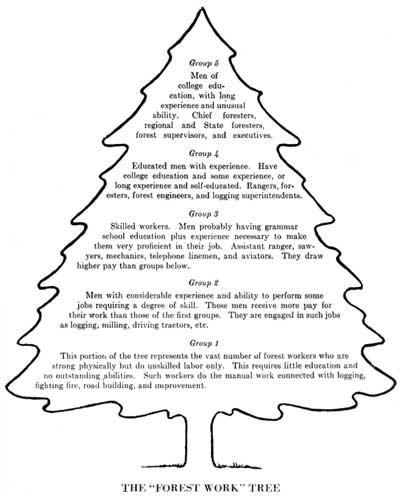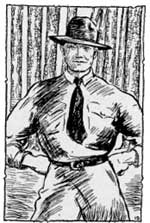|
CCC Forestry
|

|
Chapter XIV
THE WORK OF FORESTRY
|
THE NATURE OF FOREST WORK EARLY forestry methods were crude, and foresters were no more than woods policemen or wardens. Practically all their work was out of doors and of a rough nature. Today, although much of the work is still in the woods, added duties have been assigned to foresters so that most of the unskilled work is done by local laborers, supervised by foresters. SCOPE OF FORESTRY A forester is not necessarily a man who wears a regulation uniform and climbs lookout towers looking for fires. He may be a business man working in a modern office. He may be a supervisor who drives an automobile over forest roads inspecting the woods work. He may be a teacher in a college, a writer, a lumberman, or a manufacturer of wood products. A forester may be far from cities in isolated mountain regions where he works on his projects and protects the forest assigned to his care. He is a man who knows about forest problems and how to meet them. He knows the value of trees and what they mean to man. A forester who was asked to define the term, gave the following definition: "A forester is a combination business man, diplomat, evangelist, technician, and laborer who knows plenty about trees and doesn't object to hard works." STANDARDS OF FOREST WORK Forest work is wide in scope and the standards of work are high. Professional foresters try to do their work efficiently, and have earned, and been given, praise for rendering unselfish service. Because of the varied work required of foresters they should possess rather positive characteristics. A forester should be physically strong, an outdoors man, and willing to endure hardships. He should be intelligent, mentally resourceful, and congenial He should be a nature lover, and should be willing to make personal sacrifices for his work.
|
What Characteristics Should a Forester Possess?
| |||||||||||||||||||||||||||||||||||||
|
FOR NONSKILLED WORK There are various degrees of training necessary for forest workers. Many men are needed to carry on the labor of the forests such as logging, making roads and bridges, fighting fires, and planting trees. Foresters choose laborers who want to do good work, know how to do it, and will be interested in their jobs. Forest laborers must know how to work and must be strong enough to do rather heavy labor. They should have personal initiative, be willing and able to carry out directions of supervisors, and should be satisfied to do only the best grade of work. FOR SKILLED WORK The training for skilled workers must be sufficient to give them a greater degree of proficiency than is required of general laborers. Many jobs, such as construction of towers, trails, bridges, and telephone lines, demand precision in techniques and skills. Operating tractors, steam shovels, sawmills, and doing concrete and steel work are jobs requiring expert services. These skills may be obtained in trade or technical schools, or through practical experience. There are some jobs in forestry requiring administrative ability and a general knowledge of forestry as well as ability to do hard labor and skilled work. Rangers of the United States Forest Service fill these jobs. Formerly the Forest Service selected rangers by examination, from among skilled woodsmen, and practical experience was an important qualification. But today the ranger must be more than an intelligent woodsman. He must have a background of basic forestry knowledge. With rare exceptions, ranger applicants must have studied in an approved forest school before being eligible for examination and appointment. Similar training and abilities are required of foremen in the Civilian Conservation Corps. The Civil Service Commission has given examinations to enrollees who desire advancements to the technical staff. Knowledge of the work, ability to direct men, and a basic understanding of forestry and conservation are requisites of a good forest-work foreman. Candidates for this position should apply themselves to their work and take advantage of the technical education opportunities offered in the camp.
FOR PROFESSIONAL FORESTERS Young men who wish to prepare themselves for professional forestry work must undergo a long period of study and training. To begin with, they should make a personal evaluation of their own characteristics, to determine whether they possess the essential qualities required for the forestry profession. They should also make a study of the field of employment and their chances to find jobs after they have prepared themselves. Finally, they must decide whether they have or can obtain the money required for the 4 or 5 years of collegiate study. The cost of a 4-year course in forestry varies from about $2,000 for the thrifty student in a school where expenses are low, to about $5,000 for the average student in more expensive schools. The training of foresters begins with the fundamentals of the work. Classroom study is combined with actual field work where students learn to use forest tools. They learn forest principles, and methods of applying them. After fundamental knowledge is acquired, forest students usually specialize in a particular phase of forestry. Upon completion of their standard course, many students specialize in study for an additional advanced degree. The 4-year course prepares students for the bachelor degree in science or forestry, the 5- or 6-year course for the degree of master of forestry (or science).
The following subjects generally are studied by forest students: 1. Preparatory subjects
2. Technical subjects
3. Allied subjects
Many of these subjects overlap and many are not studied in detail except by students specializing in them. There are many other allied subjects which may be used to advantage by foresters. There are 25 schools in the United States offering degrees in forestry. Some of these schools offer a very high type of instruction, while others have poorer facilities and have not been so well developed. In addition to the forest schools many colleges and universities offer courses in forestry not leading to a degree. These general courses lead to further study, and fit men for work in fields allied to professional forestry. Forest schools in the United States 1. University of California.
POSSIBILITIES FOR EMPLOYMENT Many phases in the field of forestry must be considered before one can predict future employment possibilities. Before CCC emergency employment, made necessary by the depression, there were five or six thousand foresters. These are now all employed. Forest schools in 1934 graduated over 400 foresters, and enrollments increased 68 percent in 1935. At present about 6,000 students are enrolled. If this increase continues, many graduate foresters may be unable to find employment of the type they desire. They may find it necessary to take labor jobs, and to do the work formerly done by untrained men. Forest schools give a broad training which enables the forester to adapt himself readily to allied scientific and public service occupations. Many foresters enter educational fields as professors of science, botany, forestry, and similar subjects. Others establish businesses as nurserymen and landscape architects. The wood-using industries—furniture making, wood distillation, paper manufacture—employ foresters as specialists and technical advisers. All forestry courses include the study of engineering and mathematics which enable graduates to find employment as engineers and surveyors with highway departments.
The forestry profession, like industry, is always looking for good men. A young man who has the ability and determination may succeed in spite of numbers. The average young man entering a forest school in 1937 or thereafter should have done considerable thinking, and should not be unduly optimistic regarding his opportunities. He should know what odds are against him. |
Jobs Requiring High Type of Ability. Qualifications for Rangers. T
Costly Too. How Professional Foresters Are Trained. College Degrees.
| |||||||||||||||||||||||||||||||||||||
|
JOBS IN THE FEDERAL FORESTRY PROGRAM Employment by the Government is largely, though not entirely, confined to employment in the United States Forest Service. The Forest Service is a bureau of the Department of Agriculture, employing regularly more than 6,000 people. The diagram on the next page shows the organization of the service and the positions held by its employees. It does not show the employment of hundreds of assistants, such as technicians, secretaries, typists, and messengers.
|
| |||||||||||||||||||||||||||||||||||||
|
As shown by the chart, most of the employment is on the national forests. The six major functional units of service are each headed by an assistant chief in the Washington office. Each of these branches is related to management of the national forests. REGIONAL OFFICES Ten regional offices have been established so that the business of the different regions can be Regional Forests. handled more efficiently. Each region has its regional forester with his assistants. The work on the forests located in each region is under the administration of the regional forester. Each national forest (there are 142 of them plus 35 purchase units) has a forest supervisor, whose office is in or near the forest, with office assistants and supervisors. Each forest is divided into two or more ranger districts, and a ranger directly supervises the work of the district. The ranger district may be subdivided, the subdistrict being in charge of an assistant ranger. Much work is done by temporary employees.
In addition to the 10 forest regions of the Forest Service, employing foresters and rangers, there are 11 Federal forest experiment stations and a forest products laboratory. Foresters and forest workers carry on research in these stations and make experiments relating to the better development and utilization of forest products. Other Government agencies employing foresters are the National Park Service, the Soil Conservation Service, the Biological Survey, and the Bureau of Indian Affairs. Forestry is directly related to these Federal agencies, but all these together employ regularly only 22 percent as many foresters as the Forest Service alone. The employment of foresters as here discussed refers to regular employment. Emergency employment will be treated separately. JOBS IN PRIVATE FORESTRY Jobs in private forestry are generally connected with the lumber industry. Lumbermen see the necessity of growing timber crops and managing their forests to provide for sustained yield. Increasing numbers of foresters are being employed by lumber companies, pulp and paper manufacturers, and other industrial forest organizations. As in Federal and State forestry, the types of work range from labor jobs to high executive positions. Forest labor may include felling and bucking trees, stand improvement, sawmilling, trail building, and fire fighting. Jobs requiring skill include cruising and scaling timber, logging by machinery, treating lumber, inspecting and grading lumber, and other similar work. Higher positions requiring definite abilities are those related to forest management, manufacturing, marketing, and research. Often foresters are executives of large corporations whose operations include forestry and lumbering. Consulting foresters are professional men who offer their advice and services to the public and charge fees for service rendered. Few foresters enter the consulting field, as there is little demand at present for consulting foresters. This work may be associated with some other business, such as operating a nursery or landscape architectural service, to form a profitable business. STATE FORESTRY Although State forestry had its beginnings years ago, very few States had forestry organizations prior to 1920. Today all the States have organizations for forestry work and 40 employ technical foresters. Pennsylvania and New York lead in the employment of foresters and forest workers. The former has 61 foresters and the latter 40. These two States own more than half of all the State-owned forest land of the United States. The 48 States as a whole employ a total of about 300 full-time foresters (not including emergency projects) and many technicians and part-time workers. Work in State forestry may be classified as follows: a. Protecting and developing State-owned forests and parks. b. Educating the public in forest conservation and use. Furnishing technical information to private forest owners. c. Managing forest nurseries to furnish seedlings demanded throughout the State. d. Cooperating with private owners in protecting their forests from fire and in making forest improvements. e. Carrying on research in forestry. f. Planning for and acquiring State forest land. EDUCATIONAL WORK About 1 out of every 10 foresters is employed in a forest school or college. Some of the best foresters of the country have been chosen as teachers. Almost all the forest schools of the country are State-owned. Although States have been rather backward in providing governmental forestry departments, many of them have organized forest schools in their universities. WHERE FORESTERS WORK The following table shows the distribution of foresters from a total of 1,718 forest school graduates of the years 1900 to 1929:2
EMERGENCY EMPLOYMENT A large part of the emergency employment incident to the recent economic depression was forestry work. The Civilian Conservation Corps with three to four hundred thousand laborers, working largely in forest improvement and protection, required the services of a great many foresters. Prior to 1933, approximately 30 percent of the five or six thousand foresters in the country were unemployed. Emergency Conservation Work has absorbed these technically trained men and thousands of men trained in other lines. Engineers, mechanics, woodsmen, executives, and work supervisors have been employed. During the first 3 years of Emergency Conservation Work, more than a million and a half men were given employment, largely in forestry work. The Civilian Conservation Corps has been administered on a cooperative basis. The Director of Emergency Conservation Work has had final authority. The Army has housed, clothed, and fed the workers, the Department of Labor has chosen the enrollees. Supervisors and technical men, under authority of the various work agencies (Forest Service, National Park Service, Soil Conservation Service, etc.) have administered and directed the actual work performed. The CCC is a marked example of splendid cooperation among Government departments. The Tennessee Valley Authority was set up in 1933. Thousands of workers have found employment in Tennessee Valley Authority forests. Soil conservation and reforestation projects carried on in connection with this enterprise have employed many foresters. Forest lands purchased by the Tennessee Valley Authority total 15,000 acres, and 6,000,000 acres of farm wood lands in the Tennessee Valley area will be under cooperative management as a result of this program.
The Shelterbelt project of the Prairie States has given employment to thousands of forest workers. This experiment may lead to wider planting for protection from wind. |
National Forests Administration.
What Is a Consulting Forester? Pennsylvania and New York Leaders in State Forestry. Functions of State Forestry Departments.
The CCC Cooperative.
| |||||||||||||||||||||||||||||||||||||
|
The compensation received by forest workers is indicated in the following table:
OTHER CONSIDERATIONS By devoting spare time to study and research, the forest worker has an opportunity to advance into the higher salary brackets. Although the forester's work is not wholly altruistic, it is of great service to the people. One who helps to establish, maintain, and protect forests is making a valuable contribution to the well-being of society. The realization that he is making this contribution is one of the satisfactions the forester derives from his profession. The work of foresters, engaged in outdoor employment, moreover, is conducive to good health and physical development. Group 5 Men of college education, with long experience and unusual ability. Chief foresters, regional and State foresters, forest supervisors, and executives. Group 4 Educated men with experience. Have college education and some experience, or long experience and self-educated. Rangers, foresters, forest engineers, and logging superintendents. Group 3 Skilled workers. Men probably having grammar school education plus experience necessary to make them very proficient in their job. Assistant ranger, sawyers, mechanics, telephone linemen, and aviators. They draw higher pay than groups below. Group 2 Men with considerable experience and ability to perform some jobs requiring a degree of skill. These men receive more pay for their work than those of the first groups. They are engaged in such lobs as logging, milling, driving tractors, etc. Group 1 This portion of the tree represents the vast number of forest workers who are strong physically but do unskilled labor only. This requires little education and no outstanding abilities. Such workers do the manual work connected with logging, fighting fire, road building, and improvement.
|
| |||||||||||||||||||||||||||||||||||||
| <<< Previous | <<< Contents>>> | Next >>> |
|
ccc-forestry/chap14.htm Last Updated: 02-Apr-2009 |
